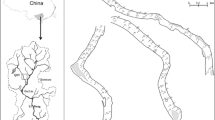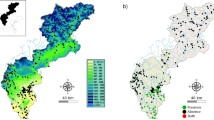Abstract
The effect of environmental conditions on river macrobenthic communities was studied using a dataset consisting of 343 sediment samples from unnavigable watercourses in Flanders, Belgium. Artificial neural network models were used to analyse the relation among river characteristics and macrobenthic communities. The dataset included presence or absence of macroinvertebrate taxa and 12 physicochemical and hydromorphological variables for each sampling site. The abiotic variables served as input for the artificial neural networks to predict the macrobenthic community. The effects of the input variables on model performance were assessed in order to identify the most diagnostic river characteristics for macrobenthic community composition. This was done by consecutively eliminating the least important variables and, when beneficial for model performance, adding previously removed ones again. This stepwise input variable selection procedure was tested not only on a model predicting the entire macrobenthic community, but also on three models, each predicting an individual taxon. Additionally, during each step of the stepwise leave-one-out procedure, a sensitivity analysis was performed to determine the response of the predicted macroinvertebrate taxa to the input variables applied. This research illustrated that a combination of input variable selection with sensitivity analyses can contribute to the development of reliable and ecologically relevant ANN models. The river characteristics predicting presence or absence of the benthic macroinvertebrates best were the Julian day, conductivity, and dissolved oxygen content. These conditions reflect the importance of discharges of untreated wastewater that occurred during the period of investigation in nearly all Flemish rivers.






Similar content being viewed by others
Abbreviations
- ANN:
-
Artificial neural network
- BBI:
-
Belgian Biotic Index
- BSI:
-
Biotic Sediment Index
- CCI:
-
Number of correctly classified instances
- RIVPACS:
-
River In Vertebrate Prediction And Classification System
- RMSE:
-
Root mean square error
- SLOO:
-
Stepwise leave-one-out
References
Beauchard O, Gagneur J, Brosse S (2003) Macroinvertebrate richness patterns in North African streams. J Biogeogr 30:1821–1833
Chapman PM, Power EA, Dexter RN, Andersen HB (1991) Evaluation of effects associated with an oil platform, using the Sediment Quality Triad. Environ Toxicol Chem 10:407–424
Chaves ML, Chainho PM, Costa JL, Prat N, Costa MJ (2005) Regional and local environmental factors structuring undisturbed benthic macroinvertebrate communities in the Mondego River basin, Portugal. Arch Hydrobiol 163:497–523
Chen S, Billings SA, Grant PM (1990) Non-linear system identification using neural networks. Int J Control 51:1191–1214
Clarke RT, Wright JF, Furse MT (2003) RIVPACS models for predicting the expected macroinvertebrate fauna and assessing the ecological quality of rivers. Ecol Model 160:219–233
Cohen J (1960) A coefficient of agreement for nominal scales. Educ Psychol Meas 20:37–46
Davies PE (2000) Development of a national river bioassessment system (AUSRIVAS) in Australia. In: Wright JF, Sutcliffe DW, Furse MT (eds) Assessing the biological quality of fresh waters: RIVPACS and other techniques. Freshwater Biological Association, Ambleside, Cumbria
De Cooman W, Florus M, Vangheluwe M, Janssen C, Heylen S, De Pauw N, Rillaerts E, Meire P, Verheyen R (1999) Sediment characterisation of rivers in Flanders. In: De Schutter G (ed) CATS4. PIH, Antwerp, Belgium
Dedecker AP, Goethals PLM, De Pauw N (2002) Comparison of artificial neural network (ANN) model development methods for prediction of macroinvertebrate communities in the Zwalm river basin in Flanders, Belgium. The Scientific World J 2:96–104
Dedecker AP, Goethals PLM, Gabriels W, De Pauw N (2004) Optimisation of Artificial Neural Network (ANN) model design for prediction of macroinvertebrate communities in the Zwalm river basin (Flanders, Belgium). Ecol Model 174:161–173
Dedecker AP, Goethals PLM, D’heygere T, Gevrey M, Lek S, De Pauw N (2005) Application of artificial neural network models to analyse the relationships between Gammarus pulex L. (Crustacea, Amphipoda) and river characteristics. Environ Monit Assess 111:223–241
Dedecker AP, Goethals PLM, D’heygere T, Gevrey M, Lek S, De Pauw N (2007) Selecting variables for habitat suitability of Asellus (Crustacea, Isopoda) by applying input variable contribution methods to Artificial Neural Network models. Environ Model Assess (in press)
De Pauw N, Vanhooren G (1983) Method for biological quality assessment of watercourses in Belgium. Hydrobiologia 100:153–168
De Pauw N, Heylen S (2001) Biotic index for sediment quality assessment of watercourses in Flanders, Belgium. Aquat Ecol 35:121–133
D’heygere T, Goethals PLM, De Pauw N (2003) Use of genetic algorithms to select input variables in decision tree models for the prediction of benthic macroinvertebrates. Ecol Model 160:291–300
D’heygere T, Goethals PLM, De Pauw N (2006) Genetic algorithms for optimisation of predictive ecosystems models based on decision trees and neural networks. Ecol Model 195:20–29
Dolédec S (1989) Seasonal dynamics of benthic macroinvertebrate communities in the Lower Ardèche River (France). Hydrobiologia 182:73–89
Dzeroski S, Grbovic J, Walley WJ, Kompare B (1997) Using machine learning techniques in the construction of models. II. Data analysis with rule induction. Ecol Model 95:95–111
Eu (2000) Directive 2000/60/EC of the European Parliament and of the Council of 23 October 2000 establishing a framework for community action in the field of water policy. Official J Eur Communities L327:1–72
Fielding AH, Bell JF (1997) A review of methods for the assessment of prediction errors in conservation presence/absence models. Environ Conserv 24:38–49
Gabriels W, Goethals PLM, De Pauw N (2002) Prediction of macroinvertebrate communities in sediments of Flemish watercourses based on artificial neural networks. Verh Internat Verein Limnol 28:777–780
Gabriels W, Goethals PLM, De Pauw N (2005) Implications of taxonomic modifications and alien species on biological water quality assessment as exemplified by the Belgian Biotic Index method. Hydrobiologia 542:137–150
Gevrey M, Dimopoulos I, Lek S (2003) Review and comparison of methods to study the contribution of variables in artificial neural network models. Ecol Model 160:249–264
Gevrey M, Rimet F, Park YS, Giraudel JL, Ector L, Lek S (2004) Water quality assessment using diatom assemblages and advanced modelling techniques. Freshwater Biol 49:208–220
Gevrey M, Dimopoulos I, Lek S (2006) Two-way interaction of input variables in the sensitivity analysis of neural network models. Ecol Model 195:43–50
Goethals PLM (2005) Data driven development of predictive ecological models for benthic macroinvertebrates in rivers. PhD thesis, Ghent University
Goethals P, De Pauw N (2001) Development of a concept for integrated river assessment in Flanders, Belgium. J Limnol 60:7–16
Goldberg DE (1989) Genetic algorithms in search, optimisation and machine learning. Addison-Wesley Publishing Company, Reading, Massachusetts
Guégan JF, Lek S, Oberdorff T (1998) Energy availability and habitat heterogeneity predict global riverine fish diversity. Nature 391:382–384
Hagan MT, Demuth HB, Beale M (1996) Neural network design. PWS Publishing Company, Boston
Hawkes HA (1997) Origin and development of the biological monitoring working party score system. Water Res 32:964–968
Heylen S, De Pauw N (2003) Mentum deformations in Chironomus larvae for assessment of freshwater sediments in Flanders, Belgium. Verh Internat Verein Limnol 28:781–785
Hoang H, Recknagel F, Marshall J, Choy S (2001) Predictive modelling of macroinvertebrate assemblages for stream habitat assessments in Queensland (Australia). Ecol Model 146:195–206
Hornik K, Stinchcombe M, White H (1989) Multilayer feedforward networks are universal approximators. Neural Networks 2:359–366
Landis JR, Koch GC (1977) The measurement of observer agreement for categorical data. Biometrics 33:159–174
Lek S, Guégan JF (1999) Artificial neural networks as a tool in ecological modelling, an introduction. Ecol Model 120:65–73
Lek S, Belaud A, Dimopoulos I, Lauga J, Moreau J (1995) Improved estimation, using neural networks, of the food consumption of fish populations. Mar Freshwater Res 46:1229–1236
Lek S, Belaud A, Baran P, Dimopoulos I, Delacoste M (1996a) Role of some environmental variables in trout abundance models using neural networks. Aquat Living Resour 9:23–29
Lek S, Delacoste M, Baran P, Dimopoulos I, Lauga J, Aulagnier S (1996b) Application of neural networks to modelling nonlinear relationships in ecology. Ecol Model 90:39–52
Linke S, Bailey RC, Schwindt J (1999) Temporal variability of stream bioassessments using benthic macroinvertebrates. Freshwater Biol 42:575–584
Logan P, Furse M (2002) Preparing for the European Water Framework Directive – making the links between habitat and aquatic biota. Aquat Conserv 12:425–437
Maier HR, Dandy GC (2000) Neural networks for the prediction and forecasting of water resource variables: a review of modelling issues and applications. Environ Modell Softw 15:101–124
Manel S, Williams HC, Ormerod SJ (2001) Evaluating absence-presence models in ecology: the need to account for prevalence. J Appl Ecol 38:921–931
Marshall J, Hoang H, Choy S, Recknagel F (2002) Relationships between habitat properties and the occurrence of macroinvertebrates in Queensland streams (Australia) discovered by a sensitivity analysis with artificial neural networks. Verh Internat Verein Limnol 28:1415–1419
Ministry of the Flemish Community (2000) Manual for the characterisation of sediments in Flemish watercourses through the TRIAD approach, second revised print (in Dutch). Administration Environment, Nature, Land and Water management (AMINAL), in cooperation with the Flemish Environment Agency (VMM), Brussels
Obach M, Wagner R, Werner H, Schmidt HH (2001) Modelling population dynamics of aquatic insects with artificial neural networks. Ecol Model 146:207–217
Olden JD, Joy MK, Death RG (2004) An accurate comparison of methods for quantifying variable importance in artificial neural networks using simulated data. Ecol Model 178:389–397
Paruelo JM, Tomasel F (1997) Prediction of functional characteristics of ecosystems: a comparison of artificial neural networks and regression models. Ecol Model 98:173–186
Randin CF, Dirnböck T, Dullinger S, Zimmermann NE, Zappa M, Guisan A (2006) Are niche-based species distribution models transferable in space? J Biogeogr 33:1689–1703
Reece PF, Reynoldson TB, Richardson JS, Rosenberg DM (2001) Implications of seasonal variation for biomonitoring with predictive models in the Fraser River catchment, British Columbia. Can J Fish Aquat Sci 58:1411–1417
Roadknight CM, Balls GR, Mills GE, Palmer-Brown D (1997) Modeling complex environmental data. IEEE T Neural Networ 8:852–862
Rosillon D (1989) The influence of abiotic factors and density-dependent mechanisms on between-year variations in a stream invertebrate community. Hydrobiologia 179:25–38
Ruse LP (1996) Multivariate techniques relating macroinvertebrate and environmental data from a river catchment. Wat Res 30:3017–3024
Schleiter IM, Borchardt D, Wagner R, Dapper T, Schmidt KD, Schmidt HH, Werner H (1999) Modelling water quality, bioindication and population dynamics in lotic ecosystems using neural networks. Ecol Model 120:271–286
Schleiter IM, Obach M, Borchardt D, Werner H (2001) Bioindication of chemical and hydromorphological habitat characteristics with benthic macro-invertebrates based on artificial neural networks. Aquat Ecol 35:147–158
Tachet H, Richoux P, Bournaud M, Usseglio-Polatera P (2002) Invertébrés d’eau douce. Systématique, biologie, écologie. CNRS Editions, Paris
VMM (2003) Water quality – water discharges 2002. Flemish Environment Agency, Aalst, Belgium
Walley WJ, Fontama VN (1998) Neural network predictors of average score per taxon and number of families at unpolluted sites in Great Britain. Water Res 32:613–622
Weigel BM, Wang L, Rasmussen PW, Butcher JT, Stewart PM, Simon TP, Wiley MJ (2003) Relative influence of variables at multiple spatial scales on stream macroinvertebrates in the Northern Lakes and Forest ecoregion, U.S.A. Freshwater Biol 48:1440–1461
Witten IH, Frank E (2000) Data mining. Practical machine learning tools and techniques with Java implementations. Academic Press, San Diego
Wright JF (2000) An introduction to RIVPACS. In: Wright JF, Sutcliffe DW, Furse MT (eds) Assessing the biological quality of fresh waters: RIVPACS and other techniques. Freshwater Biological Association, Ambleside, Cumbria, UK
Acknowledgements
The authors wish to thank ir. Tom D’heygere and Lic. Steven Heylen (Research Unit Aquatic Ecology, Ghent University), Lieven Detemmerman and ir. Ward De Cooman (Flemish Environment Agency), and AMINAL, Division Water, Brussels for providing useful data on the sediment samples in unnavigable watercourses in Flanders, Belgium, and two anonymous reviewers for valuable remarks. Andy Dedecker is a recipient of a grant of the Institute for the Promotion of Innovation by Science and Technology in Flanders (IWT). The international cooperation within this research was financed by the scientific exchange program Tournesol (project T2003.01). The applied neural network sensitivity analysis toolbox was developed within the European PAEQANN project (EVK1-CT1999-00026).
Author information
Authors and Affiliations
Corresponding author
Rights and permissions
About this article
Cite this article
Gabriels, W., Goethals, P.L.M., Dedecker, A.P. et al. Analysis of macrobenthic communities in Flanders, Belgium, using a stepwise input variable selection procedure with artificial neural networks. Aquat Ecol 41, 427–441 (2007). https://doi.org/10.1007/s10452-007-9081-7
Received:
Accepted:
Published:
Issue Date:
DOI: https://doi.org/10.1007/s10452-007-9081-7




